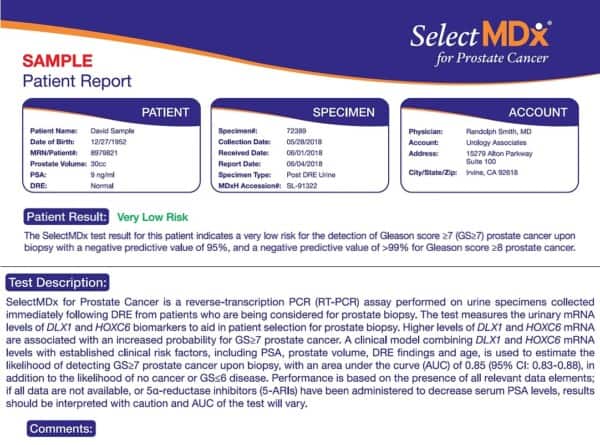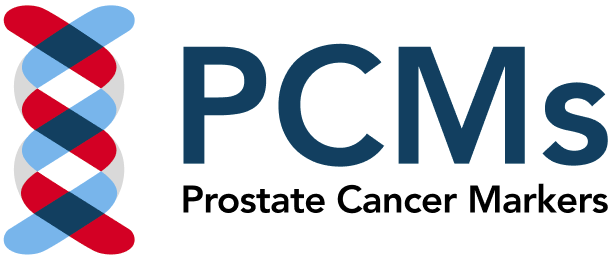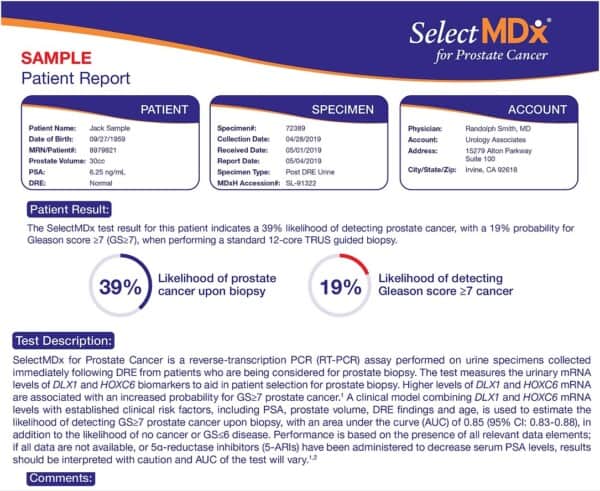What do my SelectMDx results mean?
SelectMDx is a National Comprehensive Cancer Network (NCCN) approved biomarker that was designed for patients who have an abnormal PSA and/or DRE who are being considered for a prostate biopsy.
Unlike PSA, which is a measurement that is specific to the prostate but not necessarily prostate cancer, SelectMDx has been shown in research to more accurately assess an individual’s risk of having prostate cancer, and more specifically, clinically significant prostate cancer (greater than or equal to Gleason 7).
This is done by simply collecting a sample of urine after a digital rectal examination (physical examination of ones prostate by their health care provider). There are two types of sample reports listed below, the first result being a positive test and the second result being a negative test.
Positive Test Result
Below you will find an example of a positive test result, and an explanation on areas of the report to learn what the sections mean.
Patient Result:
This section describes two statistical probabilities. The first probability: provides an overall percent risk of having any cancer on a prostate biopsy (shown here as 39%).
The second probability: provides percent risk of having clinically significant prostate cancer (greater than or equal to Gleason 7) on prostate biopsy (shown here as 19%).
These values are known as Positive Predictive Values (PPV). These percentages provide the probability (out of the worst-case scenario, which is 100%) of finding cancer upon biopsy.
Test Description:
This section describes the overall utility of the test in scientific nomenclature. In simple terms, the test looks at the levels of two different genes (DLX1 and HOXC6) present in urine. MDxHealth developed this test when they demonstrated, through research, that the specific levels of these genes, in combination with other risk factors (such as your PSA blood test result, size of your prostate, family history, and digital rectal exam), may help determine an individual’s risk of having cancer on a prostate biopsy.
It then goes on to describe a logistic regression model and the area under the curve (AUC) of .88. Generally speaking, an area of .5 represents a useless test and an area of 1 represents a perfect test. The AUC of SelectMDx is very good, and the test is quite reliable at differentiating between individuals with and individuals without prostate cancer.
There are many factors that contribute to the decision to have a prostate biopsy. It is VERY important to have an in depth discussion with your physician to decide which option is right for your particular scenario and allow them to guide you through an appropriate diagnostic plan.
Negative Test Result
Below you will find an example of a negative test result, and an explanation on areas of the report to learn what the sections mean.

Patient Result:
This sample report displays the result “Very Low Risk.” For patients with this result, it has been shown, based on research, that there is a 98% (for Gleason Score prostate cancer greater than or equal to 7) and 99.6% (for Gleason Score prostate cancer greater than or equal to 8) chance that the patient is truly negative. These values are also known as the Negative Predictive Value (NPV). Hence, this means the patient’s risk of having clinically significant prostate cancer (Gleason score greater than or equal to 7) is no greater than 2%, and the risk of having high grade prostate cancer (greater than or equal to Gleason 8) is .04%.
Test Description:
This section describes the overall utility of the test in scientific nomenclature. In simple terms, the test looks at the levels of two different genes (DLX1 and HOXC6) present in urine. MDxHealth developed this test when they demonstrated, through research, that the specific levels of these genes, in combination with other risk factors (such as your PSA blood test result, size of your prostate, family history, and digital rectal exam), may help determine an individual’s risk of having cancer on a prostate biopsy.
It then goes on to describe a logistic regression model and the area under the curve (AUC) of .88. Generally speaking, an area of .5 represents a useless test and an area of 1 represents a perfect test. The AUC of SelectMDx is very good, and the test is quite reliable at differentiating between individuals with and individuals without prostate cancer.
There are many factors that contribute to the decision to have a prostate biopsy. It is VERY important to have an in-depth discussion with your physician to decide which option is right for your particular scenario and allow them to guide you through an appropriate diagnostic plan.

